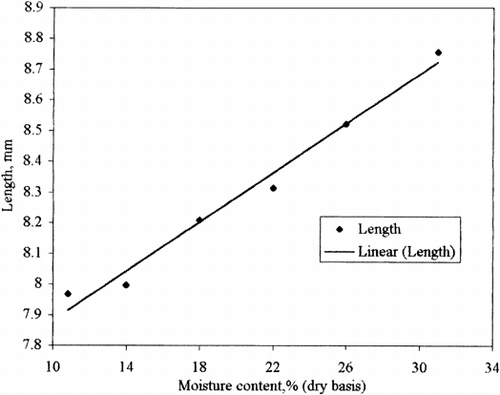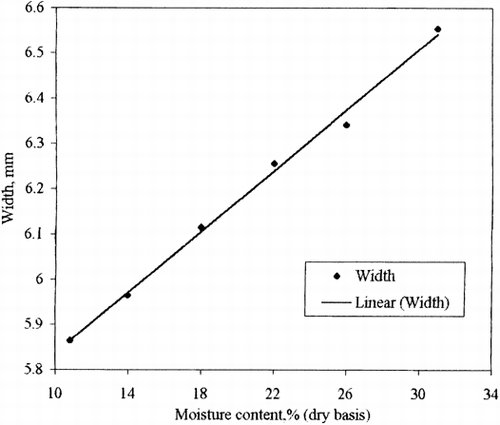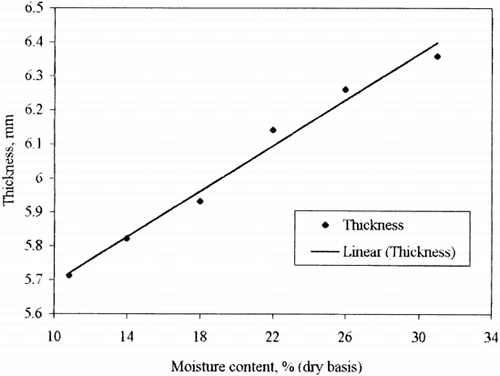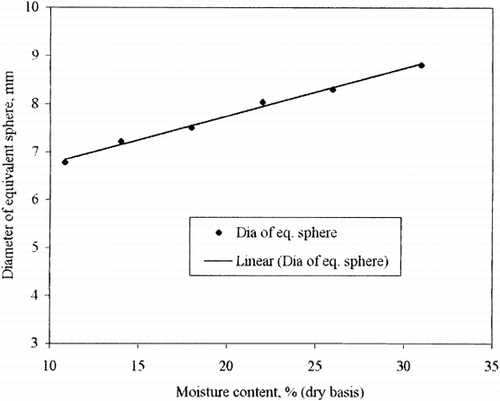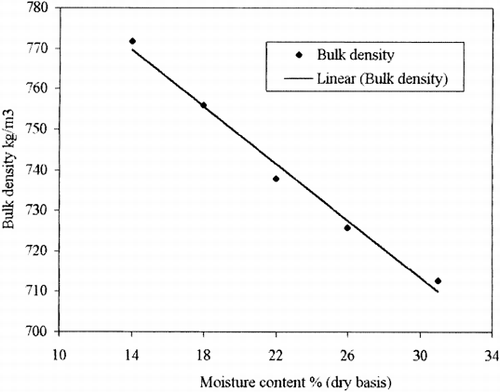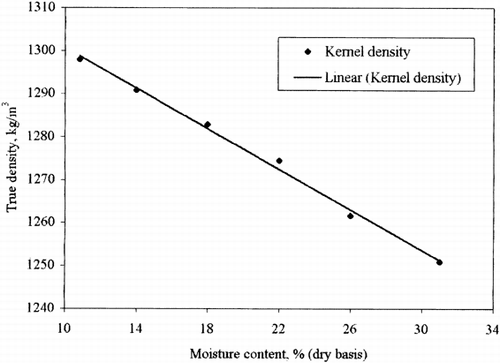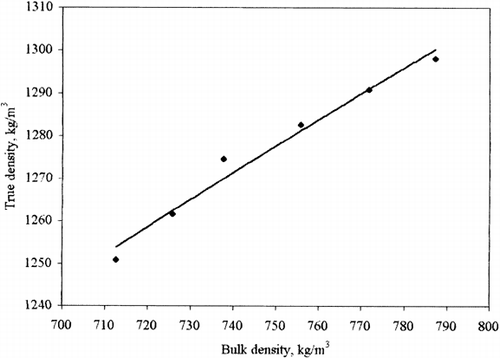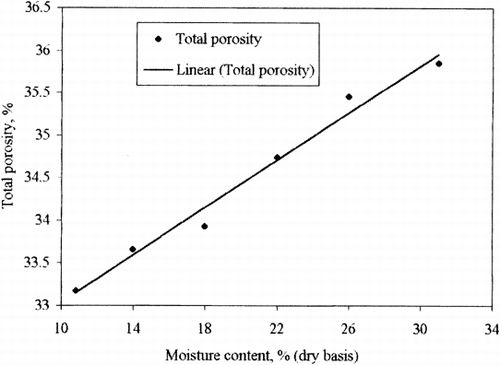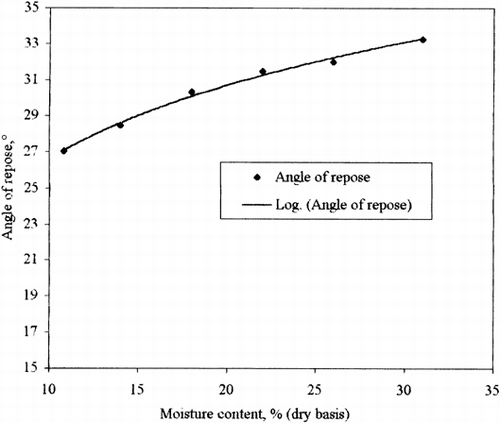Abstract
This study was carried out to determine the effect of moisture content on some physical properties of gram. Six levels of moisture content ranging from 10.83 to 31.20 percent (dry basis) were considered for this study. Length, width, thickness, diameter of equivalent sphere, mass of 1000 grains and porosity increased linearly from 7.968 to 8.758 mm, 5.864 to 6.554 mm, 5.713 to 6.359 mm, 6.770 to 8.795 mm, 137.97 to 172.73 g, and 33.17 to 35.85% respectively with the increase of moisture content from 10.83 to 31.20%. The angle of repose increased from 27.03 to 33.27° with the increase of moisture content. Bulk density and true density decreased linearly from 787.31 kg/m3 to 712.61 kg/m3 and 1398 kg/m3 to 1250 kg/m3, respectively. Static coefficient of friction was determined over plywood, galvanized steel, celluloid sheet, and glass sheet. Static coefficient of friction varied from material to material and depended on the roughness and wetness of the true. The highest coefficient of static friction was found over plywood and lowest for glass sheet among the materials tested.
INTRODUCTION
Gram (Cicer arietinum L.) an important, popular and nutritious foods for human and animal consumption. It is usually used as curry like dal. In Bangladesh, about 62,000 tons of grams are produced from 85,000 hectares of land (Razzaque et al., 2000). By increasing the consumption of gram, protein deficiency in population can be overcomed in Bangladesh.
Recently scientists have made great efforts in evaluating basic physical properties of agricultural materials and have pointed out their practical utility in machine and structural design and in process and control engineering (Waziri and Mittal, 1983). Although the recent scientific development have improved the handling and processing of bio-materials through mechanical, thermal, electrical, optical and other techniques, a little is known about the basic physical characteristics of bio-materials. Such basic information is important not only to engineers but also to food scientists, processors, plant breeders and other scientists who may find new uses (Mohsenin, 1970). Dimensions are important to design the cleaning, sizing and grading machine. Bulk density, true density and porosity are major considerations in designing the drying and aeration and storage systems, as these properties affect the resistance to air flow of the mass. Angle of Repose and co-efficient of friction are important in designing equipment for solid flow and storage structures.
Dutta et al. (1988) showed that in the moisture range from 9.64 to 31.0% (dry basis) the bulk density and true density of gram decreased with decreasing moisture content but porosity, angle of repose and static coefficient of friction over various surfaces increased with increasing of moisture content. Similar results were presented by Shepherd and Bhardwaj (1986) for pigeon pea, Sreenarayana et al. (1988) and Hossain et al. (1995) for sunflower seeds, Hossain et al. (1998) for groundnut trues, Carman (1996) for lentil and Munde (1998) for green gram. Kanawade et al. (1990) determined the particle density, bulk density, porosity and angle of repose of pigeonpea, chickpea, cowpea, pea, green gram (vigna radiata) black gram (V. Mungo), soyabean and moth bean (vigna aeonitifolial) seeds at 5 moisture levels. Results indicated that bulk density of all seeds decreased with increasing moisture content. The relationship between the moisture content and bulk density was found nonlinear. The moisture dependent physical properties of gram grown in Bangladesh are not available in literature. So, this study was undertaken to determine physical properties of gram at various moisture contents.
MATERIALS AND METHODS
Sample Preparation
This study was conducted at the Process Engineering Laboratory in the Department of Farm Power and Machinery, Bangladesh Agricultural University, Mymensingh, Bangladesh, during January to May, 2000. Dried gram of variety BARI Chhola-2 was collected from Seed Wing of Bangladesh Agricultural Development Corporation. The initial moisture content was determined by drying the gram sample in an air ventilated oven at 103°C temperature for 24 hours (Dutta et al., 1988). The samples of the selected moisture content were determined by adding calculated amount of water and sealing them in separate glass test tube and stored in a home refrigerator at 5°C. Before each experiment, the required sample was taken out from the refrigerator and kept in ambient condition for 24 hours to equilibrate the water and temperature throughout the sample. Physical properties were determined at the moisture contents of 10.83, 14.30, 18.05, 22.40, 26.03, and 31.20% (dry basis).
Determination of Physical Properties
The determination of physical dimensions of agricultural materials is much complex because of their irregular shape and variability in size. Presently no single standard method is applied in determining the physical dimensions of agricultural products (Waziri and Mittal, 1983). The dimensions of agricultural materials are measured by ordinary measuring ruler in case of big objects like coconut, cabbage, sweet potato etc., by verniar callipers or micrometer screw gauge in case of relatively small objects like maize, gram, groundnut etc. For very small objects like mustard, vegetable seeds, they are measured by shadowgraph using overhead projector.
The physical dimensions of gram were determined by picking 100 grains randomly and measuring grain length, width, and thickness at different moisture contents using a micrometer of least count 0.01 mm. The measurements were taken at room temperature of 28.0°C. Mass of 1000 grain was determined by counting 100 grains and weighing them in an electric balance and this mass was multiplied by 10 to have the mass of thousand grains. This procedure was replicated five times for each moisture level.
The bulk density and true density are the measure of the quality of grain. Bulk density of grain is the ratio of mass of grain to its bulk volume. True density is the measure of the ratio of the mass of grain to its actual volume. The bulk volume (including pore spaces between grains) of grain is greater than actual volume (without pore spaces between grains). So, bulk density of grain is smaller than that of true density. The bulk density of gram was determined by measuring the mass of gram sample of known volume. The gram sample was placed in a cylindrical container of volume 500 cm3. Packing of gram in the cylinder for density was obtained by gently tapping the cylinder vertically down to a table 30 times in the same manner in all measurements. The excess grains on the top of the cylinder was removed by sliding a string along the top edge of the cylinder. After the excess had been removed, the mass of the grain sample was measured by an electronic balance. True density or substance density was determined by toluene displacement method in order to avoid absorption of water during the experiment. Details of the terminology and measurement techniques are given by Rahman (1995). The measurements were done at room temperature of 29.0°C and replicated five times at each moisture content. The average diameter of equivalent sphere (de , m) was calculated in terms of mass of 1000 grain (W 1000, kg) and true density (ρ t , kg/m3) using following equation (Mohsenin, 1970).
The total porosity (ε) was determined by using the formula (Mohsenin, 1970).
The Angle of Repose (A) was determined by using a topless and bottomless cylinder of 10 cm diameter and 15 cm height. The cylinder was placed on a table and filled it with grams and raised slowly until it form a cone. The diameter (D) and height (H) of cone was recorded. The angle of repose (A) was calculated by using the formula as Kaleemullah (1992).
Static Coefficient of Friction
The static coefficient of friction of gram at various moisture content were determined on the surface of plywood, metal sheet, glass sheet and celluloid sheet. It was determined by a filling a hollow plastic box of dimensions 70 mm × 70 mm × 70 mm with gram according to Kaleemullah (1992). The box was pulled parallel to the surface in such a way that it just started to move and static coefficient of friction (fs ) was determined using the formula:
RESULTS AND DISCUSSION
Size
The length, width, thickness, and diameter of equivalent sphere of gram at moisture contents of 10.83, 14.30, 18.05, 22.40, 26.03, and 31.20% (dry basis) are presented in Table . It is observed from the Table that all dimensions of gram increased with the increase of moisture content. For the increase of moisture contents from 10.83 to 31.20% (dry basis), the increase of length, width, thickness, and diameter of equivalent sphere were 9.91, 11.76, 11.30, and 14.74%, respectively. The diameter of equivalent sphere was lower than the length and higher than the width and thickness. Gupta and Das. (1997), and Hossain et al., (1998) found similar results for green gram, and groundnut true. The following regression equations were developed for length, width, thickness, and diameter of equivalent sphere with moisture content (M, % dry basis).
Table 1. Length, Width, Thickness, and Diameter of Equivalent Sphere of Gram at Different Moisture Content
The regression lines of length, width, thickness, and diameter of equivalent sphere are shown in Figures and , respectively. It is clear from the Figures that the dimensions of gram linearly increase with increase of moisture content.
Mass of 1000 Grains
The mass of 1000 grains of gram at different moisture contents is presented in Table . Mass of 1000 grains of gram appeared to be dependent on moisture contents and increased linearly with the increase of moisture contents. The following regression equation was developed for mass of 1000 grains of gram for the moisture range of 10.83 to 31.20% (dry basis).
Table 2. Mass of 1000 Grains, Bulk Density, True Density, Porosity, and Angle of Repose of Gram at Different Moisture Content
The regression line of observed data and predicted values of mass of 1000 grains vs. moisture content are shown in Figure . Bala and Woods (1991) and Hossain et al. (1995) presented the similar results for malts, and sunflower seeds, respectively.
Bulk Density and True Density
The values of the bulk density and true density of kernel obtained experimentally for various moisture levels in the range of 10.83 to 31.20% (dry basis) varied from 787.31 kg/m3 to 712.61 kg/m3, and 1298 to 1250 kg/m3 respectively. The bulk density and true density decreased with the increase of moisture content and bulk density was found lower than true density at the same moisture content. The following linear regression equations were developed for bulk density and true density.
The relationship between true density and bulk density may be expressed as the following regression equation
The regression lines of bulk density, and true density with moisture content and true density with bulk density are shown in Figures , and respectively. Carman (1996), Shepherd and Bhardwaj (1986), and Kanawade et al. (1990) found the similar results for lentil, pigeon pea, and chick pea, cowpea, green gram respectively.
Porosity
Total porosity was calculated from the experimental data of bulk density and true density. The calculated values of porosity at different moisture contents are given in Table . Porosity increased from 33.17 to 35.85% at the moisture content changed from 10.83 to 31.0%. The following regression equation was developed for porosity with change of moisture content from 10.83 to 31.20% (dry basis).
Figure shows that linear relationship exists between porosity and moisture content of gram.
The porosity obtained in this study is supported by results presented by Carman (1996) for lentil, Shepherd and Bhardwaj (1986) for pigeon pea, Hossain et al. (1995) and Gupta et al. (1997) for sunflower seeds.
Angle of Repose
The experimental values of angle of repose increased from 27.03 to 33.27° with the increase of moisture content from 10.83 to 31.20% (Table ). The values of angle of repose were lower than those of green gram and sunflower seed but higher than that of pigeon pea (Shepherd and Bhardwaj (1986), Dutta et al. (1988), Kanawade et al. (1990), and Munde (1998). The following logarithmic regression equation was developed for the angle of repose of gram with moisture content.
The change of angle of repose with the increase of moisture content from 10.83 to 31.20% (dry basia) is shown in Figure . It is clear from the Figure that the angle of repose increased nonlinearly with the increase of moisture content.
Static Coefficient of Friction
The static coefficients of friction of gram on various surfaces at different moisture levels are shown in Table . It is observed from the Table that the static coefficient of friction for gram increased with moisture content on all four surfaces. The highest static coefficient of friction was observed on plywood followed by galvanized steel and celluloid sheet and lowest against glass surface. So, static coefficient of friction varied from materials to materials due their surface smoothness and also varied with the wetness of the grain. It was found that the static coefficient of friction for gram is higher than those of pigeon pea (Shepherd and Bhardwaj, 1986), and groundnut trues (Hossain et al., 1998).
Table 3. Static Coefficient of Friction of Gram on Various Surfaces at Different Moisture Levels
CONCLUSIONS
The length, width, thickness, and diameter of equivalent sphere of gram were determined and found to be increased linearly with the increase of moisture content. Bulk density, and true density decreased linearly with the increase of moisture content. Mass of 1000 grains, and porosity increased linearly, but angle of repose increased nonlinearly with the increase of moisture content. Static coefficient of friction varied from material to material and depended on the roughness and wetness of the true. Static coefficient of friction was determined over plywood, galvanized steel, celluloid sheet, and glass sheet. The highest coefficient of static friction was found over plywood and lowest for glass sheet among the materials tested.
Acknowledgments
REFERENCES
- Bala , B. K. and Woods , J. L. 1991 . Physical and Thermal Properties of Malt . Drying Technology , 9 ( 4 ) : 1091 – 1104 .
- Carman , K. 1998 . Effects of Moisture Content on Physical Properties of Green Gram . Journal of Moharastra Agricultural Universities , 22 ( 3 ) : 324 – 327 .
- Dutta , S. K. , Nema , V. K. and Bhardwaj , R. K. 1988 . Physical Properties of Gram . Journal of Agricultural Engineering Research , 39 : 259 – 268 .
- Gupta , R. K. and Das , S. K. 1997 . Physical Properties of Sunflower Seeds . Journal of Agricultural Engineering Research , 66 : 1 – 8 .
- Hossain , M. A. , Alam , M. M. and Huq , M. M. 1995 . Effect of Moisture Content on Physical Characteristics of Sunflower Seeds . Journal of Agricultural Machinery and Mechanization , 2 ( 1 ) : 41 – 44 .
- Hossain , M. A. , Khaleque , M. A. and Hassan , M. S. 1998 . Physical Characteristics of Groundnut Trues at Various Moisture Contents . Legume Research , 21 ( 2 ) : 79 – 84 .
- Kaleemullah , S. 1992 . The Effect on Moisture Content on the Physical Properties of Groundnut Kernels . Tropical Sciences , 32 : 129 – 136 .
- Kanawde , L. R. , Bhosale , B. W. and Kadam , M. S. 1990 . Effects of Moisture Content on Certain Selected Physical Properties of Pulse Seeds . Journal of Moharastra Agricultural Universities , 15 ( 1 ) : 60 – 62 .
- Mohesenin , N. N. 1970 . Physical Properties of Plant and Animal Materials 51 – 87 . New York : Gordon and Breach Science Publishers Inc. .
- Rahman , M. S. 1995 . Food Properties Handbook Boca Raton, FL : CRC Press .
- Razzaque , M. A. , Satter , M. A. , Amin , Md. , Sadrul , Quayyum , M. A. and Alam , M. S. 2000 . Krishi Pojukti Hatboi (Handbook on Agro-technology) , 2nd ed. Gazipur, , Bangladesh : Bangladesh Agricultural Research Institute .
- Shepherd , H. and Bhardwaj , R. K. 1986 . Moisture Dependent Physical Properties of Pigeon Pea . Journal of Agricultural Engineering Research , 35 : 227 – 234 .
- Sreenarayana , V. V. , Visvanathan , R. and Subramanijam , V. 1988 . Physical and Thermal Properties of Soybean . Journal of Agricultural Engineering (ISAE) , 25 ( 4 ) : 25 – 31 .
- Waziri , A. N. and Mittal , J. P. 1983 . Design Related Physical Properties of Selected Agricultural Products . Agricultural Mechanization in Asia, Africa and Latin America , 14 ( 1 ) : 59 – 62 .
